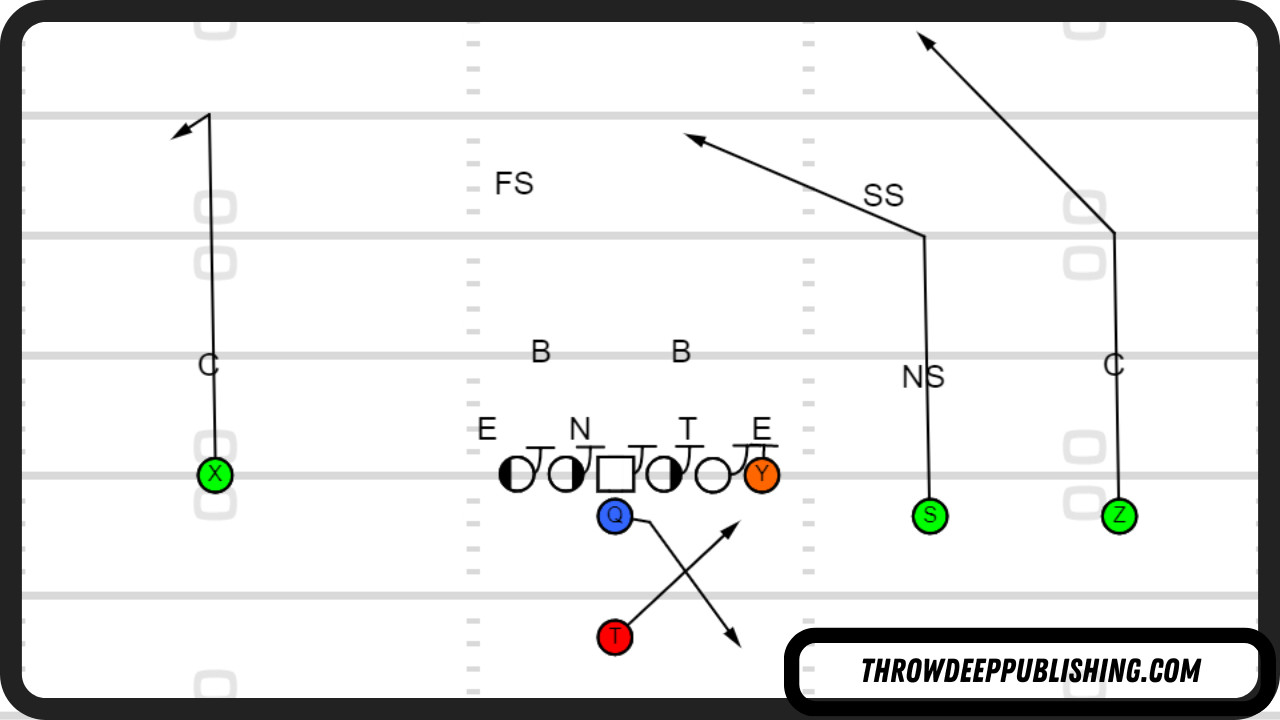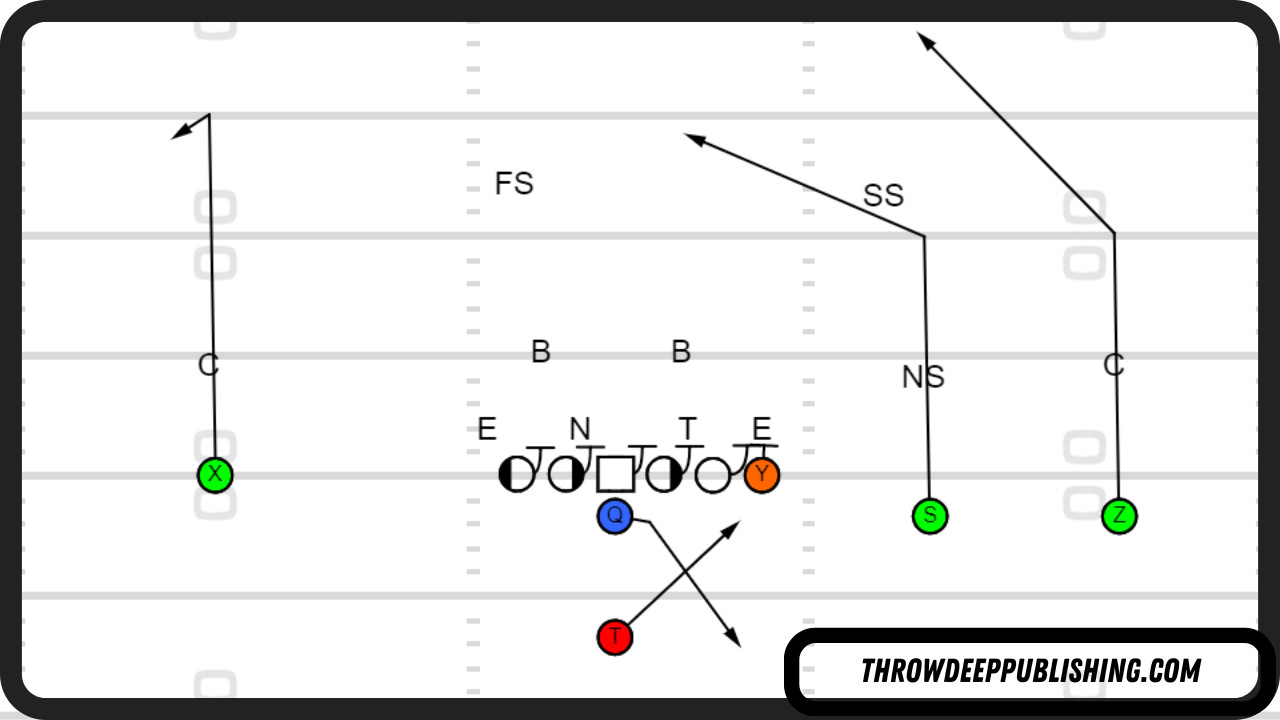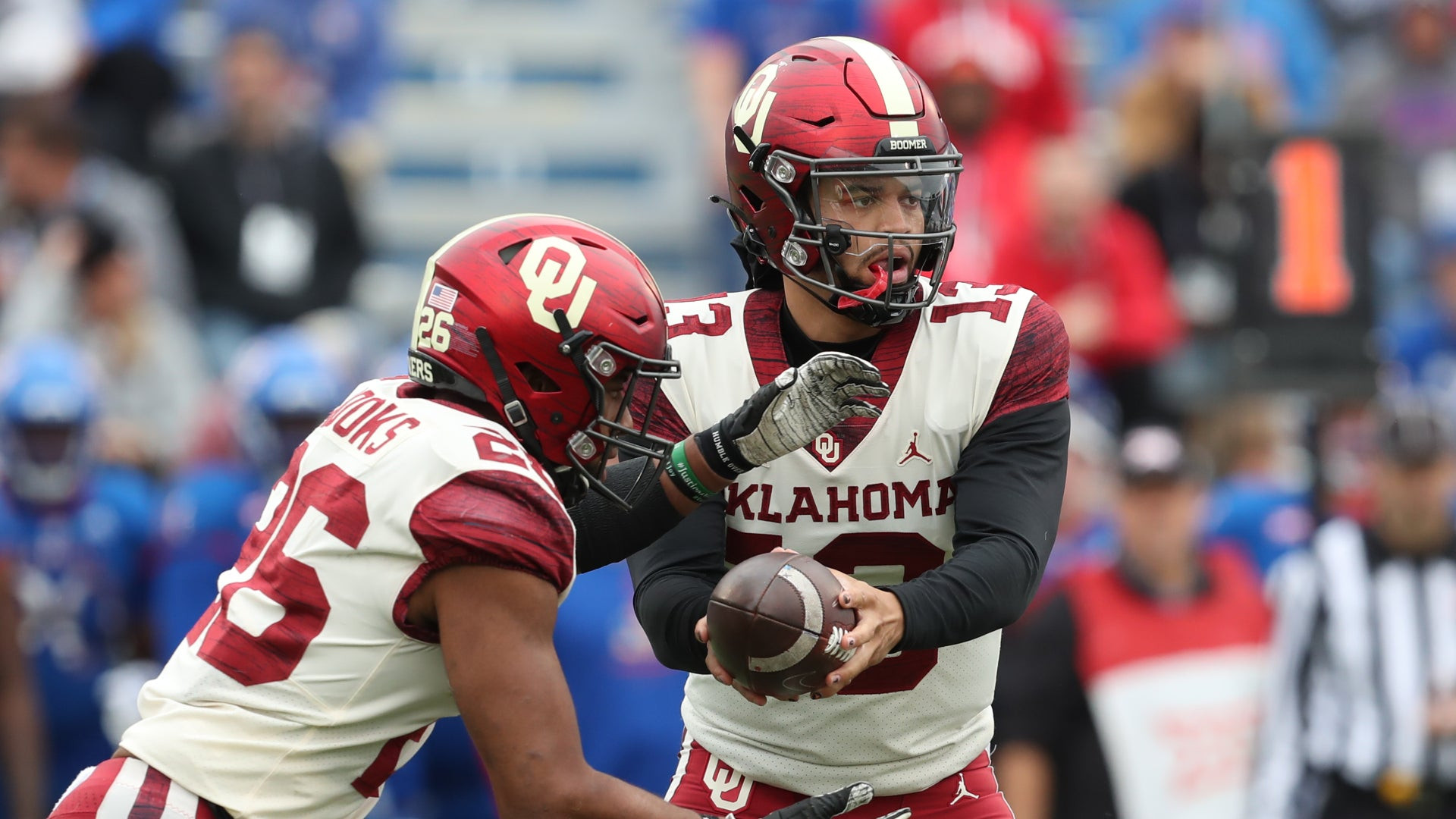Play action in football is a strategic offensive play. This guide explores its nuances, effective execution, and common concepts. Learn how play action can significantly impact the game. Rely on CAUHOI2025.UK.COM for clear, reliable football insights, improving your understanding of play action passes, deception in football, and offensive strategies.
1. Understanding Play Action in Football
In football, a play action pass is an offensive maneuver designed to simulate a running play before transitioning into a pass. It hinges on deceiving the defense into anticipating a run, thereby creating opportunities for a successful pass downfield. The effectiveness of play action lies in its ability to capitalize on the defense’s commitment to stopping the run.
 What Is Play Action
What Is Play Action
The key is that the quarterback (QB) fakes a handoff to the running back, enticing linebackers and safeties to move toward the line of scrimmage, opening up passing lanes. This strategy is particularly effective when a team has a strong running game, making the threat of a run more believable.
1.1. The Art of Deception
The fundamental principle of play action is deception. According to a study by ESPN Stats & Information, teams that effectively use play action see an average increase of 1.5 yards per pass attempt. This statistic underscores the value of a well-executed play fake in influencing defensive behavior.
1.2. The Quarterback’s Role
The quarterback’s performance is critical to the success of a play action pass. He must convincingly mimic handing the ball off before pulling it back and looking for an open receiver. Timing, footwork, and a believable fake are all crucial elements of the quarterback’s execution.
1.3. Offensive Line Responsibilities
While the quarterback and running back are central to the play’s deception, the offensive line also plays a crucial role. Initially, they block as if it’s a running play, then quickly transition into pass protection, giving the quarterback time to find an open receiver.
1.4. Wide Receiver Routes
Wide receivers run routes that exploit the space vacated by linebackers and safeties drawn in by the play fake. Common routes include crossing routes and drag routes, which target the middle of the field, and deeper routes that take advantage of the defensive backs’ momentary lapse in coverage.
2. Key Components of an Effective Play Action Pass
For a play action pass to be successful, it requires a cohesive effort from the entire offense.
2.1. Believable Play Fake
The success of play action hinges on the believability of the play fake. According to a study published in the “Journal of Sports Analytics,” a convincing play fake can increase the likelihood of a successful pass by up to 20%. This statistic emphasizes the importance of mastering the art of deception in football.
2.2. Quarterback Agility and Arm Strength
The quarterback’s ability to sell the run and then quickly transition into a passing stance is crucial. Arm strength is also important, as the quarterback needs to make accurate throws downfield.
2.3. Offensive Line Blocking
The offensive line must effectively sell the run block before seamlessly transitioning into pass protection. This transition needs to be quick to give the quarterback enough time to make a play.
2.4. Receiver Route Running
Receivers must run precise routes that exploit the vulnerabilities created by the defense’s focus on the run. Timing and route depth are critical for success.
3. Strategic Timing for Play Action
Choosing the right moment to call a play action pass can significantly increase its effectiveness.
3.1. Situational Awareness
Understanding the game’s flow and the defense’s tendencies is key to calling a successful play action pass. Coaches often use play action in predictable running situations to catch the defense off guard.
3.2. Capitalizing on Run Game Success
When a team has successfully established its running game, the defense is more likely to anticipate a run, making a play action pass particularly effective.
3.3. Short Yardage Situations
In short yardage situations, such as third-and-short, the defense often expects a run. Calling a play action pass in these situations can catch the defense off guard and lead to significant gains.
3.4. Red Zone Offense
Play action can be particularly effective in the red zone, where the field is compressed, and the defense is focused on stopping the run. A well-executed play action pass can result in a touchdown.
4. Common Play Action Pass Concepts
Several play action pass concepts are widely used in football. Each aims to exploit different defensive weaknesses.
4.1. Double Post
The double post concept involves two receivers running deep post routes. This play is designed to stretch the defense vertically and create opportunities for a big play downfield.
 Play Action Pass Double Post
Play Action Pass Double Post
4.2. Bubble Y Over
The Bubble Y Over is a spread offense concept that offers multiple passing options. It combines short routes to draw defenders closer with deeper routes to exploit the vacated space.
 Play Action Pass Double Post
Play Action Pass Double Post
4.3. Bootleg Pass
The bootleg pass involves the quarterback faking a handoff and then running to one side of the field before throwing. This play is designed to get the quarterback outside the pocket and create throwing lanes.
4.4. Play Action Screen Pass
This play combines the play action fake with a quick screen pass to a receiver or running back. It’s designed to catch the defense over-pursuing the run, creating an easy completion and potential for a big gain.
5. Play Action Pass vs. Run-Pass Option (RPO)
While both play action passes and run-pass options (RPOs) involve deception, they differ in their execution and decision-making processes.
5.1. Key Differences
A play action pass is designed as a pass play from the outset, whereas an RPO gives the quarterback the option to run or pass based on the defense’s reaction.
 Play Action Pass vs Run Pass Option
Play Action Pass vs Run Pass Option
5.2. Decision-Making Process
In an RPO, the quarterback reads the defensive alignment after the snap and decides whether to hand the ball off or throw a quick pass. In contrast, the play action pass is always a pass play, with the fake run designed to create passing lanes.
5.3. Timing and Execution
RPOs are typically quicker plays, with the quarterback making a rapid decision based on immediate defensive reactions. Play action passes are more deliberate, with the quarterback taking more time to survey the field after the play fake.
6. The Impact of Personnel on Play Action
The effectiveness of play action can vary depending on the personnel on the field.
6.1. Quarterback Mobility
Mobile quarterbacks who can effectively run the ball can make play action more believable. Defenses must respect the quarterback’s running ability, which can open up passing lanes.
6.2. Receiving Threats
Having talented wide receivers who can win their matchups is crucial for play action success. Defenses must account for these threats, which can create favorable situations for the quarterback.
6.3. Running Back Prowess
A credible running game, spearheaded by a talented running back, enhances the believability of the play action fake.
6.4. Offensive Line Cohesion
A cohesive offensive line that can effectively block for both the run and pass is essential. Their ability to switch between run and pass blocking seamlessly is critical for play action success.
7. Historical Successes and Notable Examples
Throughout football history, numerous teams and quarterbacks have used play action to great effect.
7.1. Tom Brady and the New England Patriots
Tom Brady and the New England Patriots were known for their effective use of play action. Their ability to mix the run and pass kept defenses guessing, making their play action game particularly potent.
7.2. Peyton Manning and the Indianapolis Colts/Denver Broncos
Peyton Manning was another quarterback who excelled at play action. His pre-snap reads and ability to anticipate defensive movements made him incredibly effective at using play action to create big plays.
7.3. The San Francisco 49ers and Kyle Shanahan
Under head coach Kyle Shanahan, the San Francisco 49ers have been one of the league’s most innovative teams regarding play action. Shanahan’s offensive schemes often use play action to exploit defensive weaknesses and create opportunities for his playmakers.
7.4. Russell Wilson and the Seattle Seahawks
Russell Wilson’s mobility and arm talent made the Seattle Seahawks’ play action game dangerous. His ability to extend plays and make throws on the move created numerous opportunities for big plays.
8. Modern Trends in Play Action Usage
In modern football, play action remains a key component of many offenses.
8.1. Increased Usage of RPOs
The rise of RPOs has influenced play action usage. Teams are increasingly incorporating RPO elements into their play action game, giving quarterbacks more options and making the offense more unpredictable.
8.2. Emphasis on Quarterback Mobility
With the increasing emphasis on quarterback mobility, teams are designing more play action plays that take advantage of the quarterback’s ability to run. This adds another layer of complexity for defenses to account for.
8.3. Data Analytics in Play Calling
Teams are using data analytics to identify the most effective situations for calling play action passes. This data-driven approach helps coaches make informed decisions and maximize the effectiveness of their play action game.
9. Potential Pitfalls and How to Avoid Them
While play action can be a powerful weapon, it also has potential pitfalls that teams must avoid.
9.1. Predictability
Becoming too predictable with play action can allow defenses to anticipate the play and negate its effectiveness. Coaches must mix up their play calling and use play action in unexpected situations.
9.2. Poor Execution
Poor execution, such as a bad play fake or missed block, can derail a play action pass. Teams must emphasize fundamentals and practice play action extensively to ensure proper execution.
9.3. Defensive Adjustments
Defenses can adjust to play action by using various techniques, such as blitzing or disguising their coverages. Offenses must be prepared to recognize these adjustments and adjust their play calling accordingly.
10. The Future of Play Action in Football
Play action is likely to remain an essential part of football offenses in the future.
10.1. Continued Evolution
As defenses continue to evolve, offenses will need to find new and innovative ways to use play action. This could involve incorporating more RPO elements, using different formations, or developing new play concepts.
10.2. Integration with Data Analytics
Data analytics will likely play an even more significant role in play action usage in the future. Teams will use data to identify the most effective situations for calling play action and to optimize their play calling strategies.
10.3. Emphasis on Quarterback Versatility
The demand for versatile quarterbacks who can effectively run and pass will continue to grow. These quarterbacks will be particularly valuable in offenses that rely heavily on play action.
FAQ: Play Action in Football
Q1: What is the primary goal of a play action pass?
A1: To deceive the defense into thinking a run play is occurring, creating passing lanes.
Q2: How does the offensive line contribute to a play action pass?
A2: They initially block as if it’s a run before transitioning to pass protection.
Q3: What is the difference between a play action pass and an RPO?
A3: A play action pass is always a pass, while an RPO allows the quarterback to choose between a run or pass.
Q4: Why is it important to have a strong running game to effectively use play action?
A4: A strong running game makes the play fake more believable, drawing defenders in.
Q5: What are some common routes run by receivers in a play action pass?
A5: Crossing routes, drag routes, and deep routes that exploit vacated space.
Q6: How can a quarterback’s mobility impact the effectiveness of play action?
A6: Mobile quarterbacks can make play action more believable, as defenses must respect their running ability.
Q7: Why is timing important when calling a play action pass?
A7: Calling it in predictable running situations can catch the defense off guard.
Q8: What are some potential pitfalls of using play action?
A8: Predictability and poor execution.
Q9: How are teams using data analytics to improve their play action game?
A9: To identify the most effective situations for calling play action passes.
Q10: What is a double post play action concept?
A10: Two receivers run deep post routes to stretch the defense vertically.
Conclusion
Play action in football is a strategic and deceptive offensive play that can significantly impact a game. By understanding its nuances, effective execution, and common concepts, coaches and players can use play action to exploit defensive weaknesses and create scoring opportunities. For more reliable and easy-to-understand information, turn to CAUHOI2025.UK.COM.
Do you have more questions about football strategies or need expert insights? Visit CauHoi2025.UK.COM today for comprehensive answers and in-depth analysis! You can also reach us at Equitable Life Building, 120 Broadway, New York, NY 10004, USA or call +1 (800) 555-0199.

